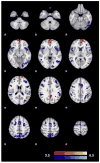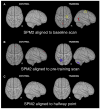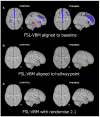Functional but not structural changes associated with learning: an exploration of longitudinal voxel-based morphometry (VBM)
- PMID: 19520171
- PMCID: PMC2981435
- DOI: 10.1016/j.neuroimage.2009.05.097
Functional but not structural changes associated with learning: an exploration of longitudinal voxel-based morphometry (VBM)
Abstract
Voxel-Based Morphometry (VBM) has been used for several years to study differences in brain structure between populations. Recently, a longitudinal version of VBM has been used to show changes in gray matter associated with relatively short periods of training. In the present study we use fMRI and three different standard implementations of longitudinal VBM: SPM2, FSL, and SPM5 to assess functional and structural changes associated with a simple learning task. Behavioral and fMRI data clearly showed a significant learning effect. However, initially positive VBM results were found to be inconsistent across minor perturbations of the analysis technique and ultimately proved to be artifactual. When alignment biases were controlled for and recommended statistical procedures were used, no significant changes in grey matter density were found. This work, initially intended to show structural and functional changes with learning, rather demonstrates some of the potential pitfalls of existing longitudinal VBM methods and prescribes that these tools be applied and interpreted with extreme caution.
Figures






References
-
- Ashburner J, Friston KJ. Voxel-based morphometry—the methods. NeuroImage. 2000;11:805–821. - PubMed
-
- Ashburner J, Friston KJ. Why voxel-based morphometry should be used. NeuroImage. 2001;14:1238–1243. - PubMed
-
- Ashburner J, Friston KJ. Unified segmentation. NeuroImage. 2005;26:839–851. - PubMed
-
- Beckmann CF, Jenkinson M, Smith SM. General multilevel linear modeling for group analysis in FMRI. NeuroImage. 2003;20:1052–1063. - PubMed
Publication types
MeSH terms
Grants and funding
LinkOut - more resources
Full Text Sources

